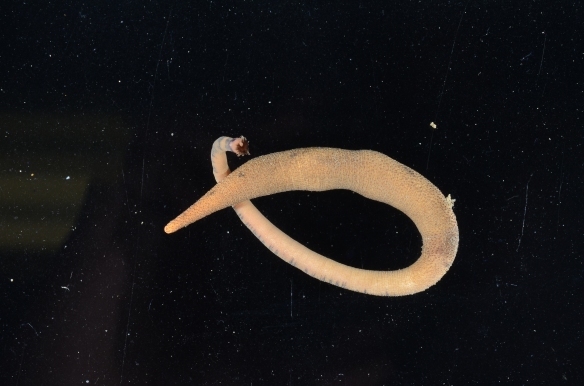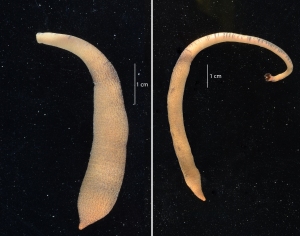
Figure 1: Phascolosoma agassizii with its introvert fully evaginated from the body cavity (coelom). At the most anterior end of Phascolosoma spp., a notch in the crown of red tentacles indicates the dorsal orientation (Kozloff, 1990).
One of the major features of the phylum Sipuncula, or the Peanut Worms, is the presence of an introvert extending from a round, vermiform trunk. The introvert has two pairs of retractor muscles that connect the apical portion of the introvert (which bears the tentacles) to the inner trunk body wall. This allows the animal to retreat into the coelomic cavity or extend its introvert and nearly double its length. To extend its introvert, the retractor muscles relax; this allows the internal pressure within the coelom to force the introvert outwards. (Kozloff, 1990)

Figure 2: Diagram shows a pictorial representation of the internal anatomy of P. agassizii. Two pairs of large retractor muscles attach low within the trunk body wall and allow for retraction of the introvert. The dissection this image reflects is the result of cutting along the dorsal body wall.
The specimen I observed was collected July 9th, 2013 at Argyle Beach on San Juan Island, WA. My specimen was found under a rock in a cobble slew connecting the Argyle Bay to the Argyle Lagoon. I observed this specimen in both its habitat and in a water table. My observations focused on the morphology and behavior of the introvert.
I have found there are three major methods in distinguishing trunk from introvert. The first and most obvious method is to observe the extent of invagination by the introvert. The second method in distinguishing the two features is by an abrupt narrowing of the body from trunk to body. Unfortunately, when the animal is relaxed, this difference in body width can be difficult observe. In the specimen I observed, Phasolosoma agassizii (Kozloff, 1974), the introvert could be distinguished from the trunk by the stripe pattern emerging and becoming prevalent as you moved anteriorly. A striping pattern was readily visible on the introvert, whereas the trunk was more or less spotted.
The behavior of the introvert is variable depending on the environment. When the animal is placed on a flat surface in a saltwater tank, it will evert and withdraw its introvert frequently in what superficially looks like a blind animal’s “sniffing” behavior. If given enough time, P. agassizii will move, using a series of rolls and tumbles assisted by the introvert, to a rock or sediment. It will then use its introvert to anchor itself underneath the rock, or in the sediment, and bury itself (anterior positioned down in the case of sediment burrowing). Often, I would find my specimen hiding underneath a rock. Similarly, P. agassizii in the field can be found under rocks anchored to the underlying rocks and sediments.

Figure 3: Image shows the discrepancy in length of the same specimen of P. agassizii when its introvert is near fully invaginated (left, 6 cm) and fully evaginated (right, 11 cm).
When the animal is underneath an object, it will remain there with no obvious effort to escape. Rather, it will evert its introvert completely. Moreover, despite it appearing to be in a rather uncomfortable situation, if one were to remove P. agassizii from its “pinned” state, it will ultimately roll, tumble, and pull its way back and resume being pinned with its introvert fully extended. Not only do these behaviors show the versatility of the introvert, they are also indicative of the durability of the body wall as the animal positions itself tightly under large stones.
Introverts are expressed in other animal phyla, so it appears to be a rather efficient organ. Morphologically, the introvert allows the animal to keep its trunk, which is full of essential viscera, stationary while the introvert may be extended and retracted as it searches for food in sediments. It also allows for rather unique forms of locomotion and a method to hide a large portion of its body from disturbance. Despite the basic morphology of the introvert, the behaviors are diverse and contribute to a very unique organism.
Michael Tassia
University of Washington
Citations:
Kozloff, Eugene N. “Phylum Sipuncula: Peanut Worms.” Invertebrates. Philadelphia: Saunders College Pub., 1990. 345-347. Print.
Kozloff, Eugene N., Linda H. Price, and Eugene N. Kozloff. “Phylum Sipuncula.” Marine Invertebrates of the Pacific Northwest. Seattle: University of Washington, 1987. 181. Print.
